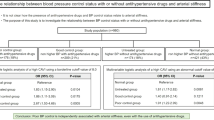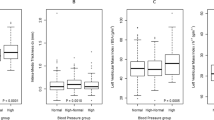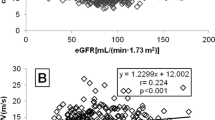Abstract
Whether impaired arterial elasticity in stage 1 hypertension can be brought back to normal by antihypertensive treatment is unknown. Aim of this study was to evaluate the impact of long-term well-controlled blood pressure (BP) on carotid artery elasticity and endothelial function in stage 1 hypertensive patients. We studied 40 middle-age hypertensives (mean age 49.7 years) whose BP had been kept at target by pharmacological treatment and/or lifestyle modifications for a mean of 7.5 years. Carotid compliance coefficient (CC) and distensibility coefficient (DC) were measured by B-mode ultrasound system. Measurement of carotid intima-media thickness (IMT) was performed in each carotid artery segment, bilaterally. Endothelial function was evaluated by post-occlusion flow mediated dilation (FMD). Forty normotensive subjects matched for age and sex served as controls. In the hypertensive subjects, BP levels were well controlled throughout the study period (mean office BP 133.7 ± 9.0/81.27 ± 7.0 mmHg). However, compared to controls, significantly higher office BP levels and waist circumference were present. Compared to normotensives, carotid elasticity (DC 24.5 ± 9.0 vs 37.0 ± 8.5 10−3/kPa, and CC 0.92 ± 0.34 vs 1.28 ± 0.36 mm2/kPa, p < 0.0005 for both) as well as endothelial function (FMD 5.7 ± 2.4% vs 9.2 ± 2.9%, p < 0.0005) were significantly impaired in hypertensives. In a logistic regression, hypertensive patients had increased risk of impaired carotid vascular stiffness (odds ratio, 95% CI: 13.04 (2.27−74.96), p = 0.004). Despite the “pseudo-normalization” of BP levels, hypertensive patients with long-term well-controlled BP according to current standards exhibited increased local arterial stiffness and endothelial dysfunction suggesting that lower BP targets should be sought.
This is a preview of subscription content, access via your institution
Access options
Subscribe to this journal
Receive 12 digital issues and online access to articles
$119.00 per year
only $9.92 per issue
Buy this article
- Purchase on Springer Link
- Instant access to full article PDF
Prices may be subject to local taxes which are calculated during checkout


Similar content being viewed by others
Change history
04 July 2022
A Correction to this paper has been published: https://doi.org/10.1038/s41371-022-00712-x
References
Williams B, Mancia G, Spiering W, Agabiti Rosei E, Azizi M, Burnier M, et al. ESC Scientific Document Group, 2018 ESC/ESH Guidelines for the management of arterial hypertension. Eur Heart J 2018;39:3021–104.
Sehestedt T, Jeppesen J, Hansen TW, Wachtell K, Ibsen H, Torp-Pedersen C, et al. Risk prediction is improved by adding markers of subclinical organ damage to SCORE. Eur Heart J 2010;31:883–91.
Paini A, Boutouyrie P, Calvet D, Tropeano AI, Laloux B, Laurent S. Carotid and aortic stiffness: determinants of discrepancies. Hypertension 2006;47:371–6.
Nilsson PM, Laurent S, Cunha PG, Olsen MH, Rietzschel E, Franco OH, et al. Metabolic syndrome, Arteries REsearch (MARE) Consortium. Characteristics of healthy vascular ageing in pooled population-based cohort studies: the global Metabolic syndrome and Artery REsearch Consortium. J Hypertens 2018;36:2340–9.
Cunha PG, Cotter J, Oliveira P, Vila I, Boutouyrie P, Laurent S, et al. Pulse wave velocity distribution in a cohort study: from arterial stiffness to early vascular aging. J Hypertens 2015;33:1438–45.
Giannarelli C, Bianchini E, Bruno RM, Magagna A, Landini L, Faita F, et al. Local carotid stiffness and intima-media thickness assessment by a novel ultrasound-based system in essential hypertension. Atherosclerosis 2012;223:372–7.
Scuteri A, Chen CH, Yin FC, Chih-Tai T, Spurgeon HA, Lakatta EG. Functional correlates of central arterial geometric phenotypes. Hypertension 2001;38:1471–5.
Pauletto P, Palatini P, Da Ros S, Pagliara V, Santipolo N, Baccillieri S, et al. Factors underlying the increase in carotid intima-media thickness in borderline hypertensives. Arterioscler Thromb Vasc Biol 1999;19:1231–7.
Puato M, Palatini P, Zanardo M, Dorigatti F, Tirrito C, Rattazzi M, et al. Increase in carotid intima-media thickness in grade I hypertensive subjects: white-coat versus sustained hypertension. Hypertension 2008;51:1300–5.
Puato M, Rattazzi M, Zanon M, Benetti E, Faggin E, Palatini P, et al. Predictors of vascular remodeling in hypertensive subjects with well-controlled blood pressure levels. J Hum Hypertens 2015;29:561–5.
Van Campenhout A, Golledge J. Osteoprotegerin, vascular calcification and atherosclerosis. Atherosclerosis 2009;204:321–9.
Musialik K, Szulińska M, Hen K, Skrypnik D, Bogdański P. The relation between osteoprotegerin, inflammatory processes, and atherosclerosis in patients with metabolic syndrome. Eur Rev Med Pharm Sci 2017;21:4379–85.
Vik A, Mathiesen EB, Brox J, Wilsgaard T, Njolstad I, Jorgensen L, et al. Relation between serum osteoprotegerin and carotid intima media thickness in a general population - the Tromso Study. J Thromb Haemost 2010;8:2133–9.
Mancia G, De Backer G, Dominiczak A, Cifkova R, Fagard R, Germano G, et al. 2007 ESH-ESC Practice Guidelines for the management of arterial hypertension: ESH-ESC task force on the management of arterial hypertension. J Hypertens 2007;25:1751–62.
Palatini P, Graniero GR, Mormino P, Nicolosi L, Mos L, Visentin P, et al. Relation between physical training and ambulatory blood pressure in stage I hypertensive subjects. Results of the HARVEST Trial. Hypertension and Ambulatory Recording Venetia Study. Circulation 1994;90:2870–6.
Puato M, Boschetti G, Rattazzi M, Zanon M, Pesavento R, Faggin E, et al. Intima-media thickness remodelling in hypertensive subjects with long-term well-controlled blood pressure levels. Blood Press 2017;26:48–53.
Casiglia E, Palatini P, Da Ros S, Pagliara V, Puato M, Dorigatti F, et al. Effect of blood pressure and physical activity on carotid artery intima–media thickness in stage 1 hypertensives and controls. Am J Hypertens 2000;13:1256–62.
Bianchini E, Bruno RM, Corciu AI, Faita F, Gemignani V, Ghiadoni L, et al. Assessment of carotid elasticity during exercise: a reproducibility study. Ultrasound Med Biol 2012;38:223–30.
Touboul PJ, Hennerici MG, Meairs S, Adams H, Amarenco P, Bornstein N, et al. Mannheim carotid intima-media thickness and plaque consensus (2004-2006-2011). An update on behalf of the advisory board of the 3rd, 4th and 5th watching the risk symposia, at the 13th, 15th and 20th European Stroke Conferences, Mannheim, Germany, 2004, Brussels, Belgium, 2006, and Hamburg, Germany, 2011. Cerebrovasc Dis 2012;34:290–6.
Deanfield J, Donald A, Ferri C, Giannattasio C, Halcox J, Halligan S, et al. Endothelial function and dysfunction. Part I: methodological issues for assessment in the different vascular beds: a statement by the Working Group on Endothelin and Endothelial Factors of the European Society of Hypertension. J Hypertens 2005;23:7–17.
Ghiadoni L, Faita F, Salvetti M, Cordiano C, Biggi A, Puato M, et al. Assessment of flow-mediated dilation reproducibility: a nationwide multicenter study. J Hypertens 2012;30:1399–405.
Lurbe E, Redon J, Kesani A, Pascual JM, Tacons J, Alvarez V, et al. Increase in nocturnal blood pressure and progression to microalbuminuria in type 1 diabetes. N Engl J Med 2002;347:797–805.
Lurbe E, Torro I, Alvarez V, Nawrot T, Paya R, Redon J, et al. Prevalence, persistence, and clinical significance of masked hypertension in youth. Hypertension 2005;45:493–8.
Bobrie G, Chatellier G, Genes N, Clerson P, Vaur L, Vaisse B, et al. Cardiovascular prognosis of “masked hypertension” detected by blood pressure self-measurement in elderly treated hypertensive patients. JAMA. 2004;291:1342–9.
Fagard RH, Cornelissen VA. Incidence of cardiovascular events in white-coat, masked and sustained hypertension versus true normotension: a meta-analysis. J Hypertens 2007;25:2193–8.
Scuteri A, Morrell CH, Orru’ M, AlGhatrif M, Saba PS, Terracciano A, et al. Gender specific profiles of white coat and masked hypertension impacts on arterial structure and function in the SardiNIA study. Int J Cardiol 2016;217:92–98.
Masoura C, Pitsavos C, Aznaouridis K, Skoumas I, Vlachopoulos C, Stefanadis C, et al. Arterial endothelial function and wall thickness in familial hypercholesterolemia and familial combined hyperlipidemia and the effect of statins. A systematic review and meta-analysis. Atherosclerosis 2011;214:129–38.
Scuteri A, Stuehlinger MC, Cooke JP, Wright JG, Lakatta EG, Anderson DE, et al. Nitric oxide inhibition as a mechanism for blood pressure increase during salt loading in normotensive postmenopausal women. J Hypertens 2003;21:1339–46.
Hansson GK. Inflammation, atherosclerosis, and coronary artery disease. N Engl J Med 2005;352:1685–95.
Zannettino AC, Holding CA, Diamond P, Atkins GJ, Kostakis P, Farrugia A, et al. Osteoprotegerin is localized to the Weibel-Palade bodies of human vascular endothelial cells and is physically associated with von Willebrand factor. J Cell Physiol 2005;204:714–23.
Puato M, Faggin E, Rattazzi M, Paterni M, Kozakova M, Palombo C, et al. In vivo noninvasive identification of cell composition of intimal lesions: a combined approach with ultrasonography and immunocytochemistry. J Vasc Surg 2003;38:1390–5.
O’Leary DH, Polak JF, Kronmal RA, Manolio TA, Burke GL, Wolfson SK Jr. Carotid-artery intima and media thickness as a risk factor for myocardial infarction and stroke in older adults. Cardiovascular Health Study Collaborative Research Group. N Engl J Med 1999;340:14–22.
Taddei S, Virdis A, Ghiadoni L, Sudano I, Salvetti A. Effects of antihypertensive drugs on endothelial dysfunction: clinical implications. Drugs 2002;62:265–84.
Ghiadoni L, Magagna A, Versari D, Kardasz I, Huang Y, Taddei S, et al. Different effect of antihypertensive drugs on conduit artery endothelial function. Hypertension 2003;41:1281–6.
Dijk JM, Algra A, van der Graaf Y, Grobbee DE, Bots ML, SMART study group. Carotid stiffness and the risk of new vascular events in patients with manifest cardiovascular disease. The SMART study. Eur Heart J 2005;26:1213–20.
Acknowledgements
The authors acknowledge the Biomedical Foundation for Cardiovascular Research and Gene Therapy of Padova, Italy, (a non-profit Institution of the University of Padova), Padova, Italy.
Author information
Authors and Affiliations
Contributions
MP and SF contributed to the conception or design of the work. MP, SF, MR, EF, and PP contributed to the acquisition, analysis, and interpretation of data for the work. MP and SF drafted the manuscript. PP critically revised the manuscript. All authors gave final approval and agree to be accountable for all aspects of work ensuring integrity and accuracy.
Corresponding author
Ethics declarations
Competing interests
The authors declare no competing interests.
Additional information
Publisher’s note Springer Nature remains neutral with regard to jurisdictional claims in published maps and institutional affiliations.
The original online version of this article was revised: Due to an error in an author name.
Supplementary information
Rights and permissions
About this article
Cite this article
Saladini, F., Rattazzi, M., Faggin, E. et al. Carotid elasticity is impaired in stage 1 hypertensive patients with well-controlled blood pressure levels. J Hum Hypertens 36, 898–903 (2022). https://doi.org/10.1038/s41371-021-00584-7
Received:
Revised:
Accepted:
Published:
Issue Date:
DOI: https://doi.org/10.1038/s41371-021-00584-7



